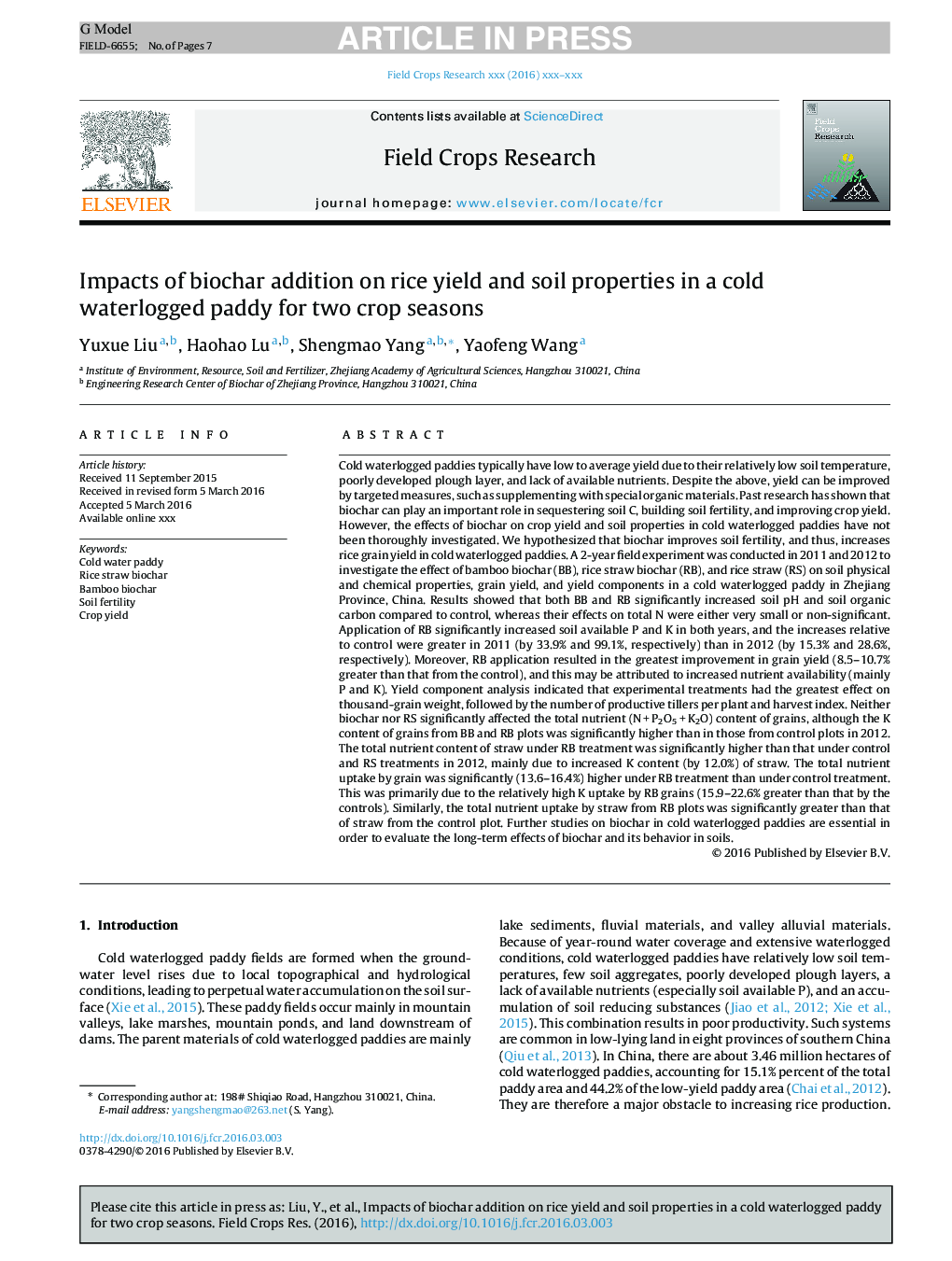| کد مقاله | کد نشریه | سال انتشار | مقاله انگلیسی | نسخه تمام متن |
|---|---|---|---|---|
| 6374611 | 1624672 | 2016 | 7 صفحه PDF | دانلود رایگان |
عنوان انگلیسی مقاله ISI
Impacts of biochar addition on rice yield and soil properties in a cold waterlogged paddy for two crop seasons
ترجمه فارسی عنوان
اثرات افزایشی افزودنی زیتون بر عملکرد برنج و ویژگی های خاک در یک آبششوی سرد برای دو فصل محصول
دانلود مقاله + سفارش ترجمه
دانلود مقاله ISI انگلیسی
رایگان برای ایرانیان
کلمات کلیدی
آب سرد برنج، زیتون قارچ برنج، زیتون بامبو، باروری خاک، بازده محصول،
موضوعات مرتبط
علوم زیستی و بیوفناوری
علوم کشاورزی و بیولوژیک
علوم زراعت و اصلاح نباتات
چکیده انگلیسی
Cold waterlogged paddies typically have low to average yield due to their relatively low soil temperature, poorly developed plough layer, and lack of available nutrients. Despite the above, yield can be improved by targeted measures, such as supplementing with special organic materials. Past research has shown that biochar can play an important role in sequestering soil C, building soil fertility, and improving crop yield. However, the effects of biochar on crop yield and soil properties in cold waterlogged paddies have not been thoroughly investigated. We hypothesized that biochar improves soil fertility, and thus, increases rice grain yield in cold waterlogged paddies. A 2-year field experiment was conducted in 2011 and 2012 to investigate the effect of bamboo biochar (BB), rice straw biochar (RB), and rice straw (RS) on soil physical and chemical properties, grain yield, and yield components in a cold waterlogged paddy in Zhejiang Province, China. Results showed that both BB and RB significantly increased soil pH and soil organic carbon compared to control, whereas their effects on total N were either very small or non-significant. Application of RB significantly increased soil available P and K in both years, and the increases relative to control were greater in 2011 (by 33.9% and 99.1%, respectively) than in 2012 (by 15.3% and 28.6%, respectively). Moreover, RB application resulted in the greatest improvement in grain yield (8.5-10.7% greater than that from the control), and this may be attributed to increased nutrient availability (mainly P and K). Yield component analysis indicated that experimental treatments had the greatest effect on thousand-grain weight, followed by the number of productive tillers per plant and harvest index. Neither biochar nor RS significantly affected the total nutrient (NÂ +Â P2O5Â +Â K2O) content of grains, although the K content of grains from BB and RB plots was significantly higher than in those from control plots in 2012. The total nutrient content of straw under RB treatment was significantly higher than that under control and RS treatments in 2012, mainly due to increased K content (by 12.0%) of straw. The total nutrient uptake by grain was significantly (13.6-16.4%) higher under RB treatment than under control treatment. This was primarily due to the relatively high K uptake by RB grains (15.9-22.6% greater than that by the controls). Similarly, the total nutrient uptake by straw from RB plots was significantly greater than that of straw from the control plot. Further studies on biochar in cold waterlogged paddies are essential in order to evaluate the long-term effects of biochar and its behavior in soils.
ناشر
Database: Elsevier - ScienceDirect (ساینس دایرکت)
Journal: Field Crops Research - Volume 191, May 2016, Pages 161-167
Journal: Field Crops Research - Volume 191, May 2016, Pages 161-167
نویسندگان
Yuxue Liu, Haohao Lu, Shengmao Yang, Yaofeng Wang,
